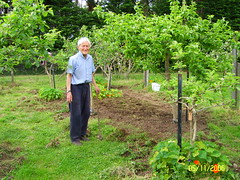
SV100807.jpg
Originally uploaded by localcurrencies.
Actually the term herbal ley isn't all that accurate, because they aren't all herbs. But here is Malcolm after a session grubbing the turf, reasonably easy after all the rain. And it should be good conditions for germinating because it is nearly full moon as well. We bought the King Seeds Beneficial Insect Mix but asked them to leave out the fennel.
It consists of buckwheat (white flowers), dill, Bishops flower (ammi major or white lace), parsnip, ammi visnaga (white lacy again), daucus carota (wild carrot or Queen Anne's lace), phacelia, bergamot (bee balm orange or pink) and alyssum (white). We will also put some clovers and alfalfa in.
The blue phacelia already have flowering is attracting a huge range of insects and we have borage, nasturtium, comfrey and a few herbs growing. This year's apple crop looks really promising and the soil is looking reasonably good. The only apple tree which hasn't set much fruit is the one which fruited heavily last year. It seems to be having a year off.
I must say after all the grubbing we get really tired. I can only do 45 minutes of it at a time.

1 comment:
Many plants from China can be used for treatment of medical conditions. One of them is chai hu. This plant with slender rods is known to be able to help overcome pain, fever, typhoid, and relieve depression, and maybe also anxiety and panic attacks symptoms. But they should be not as effective as Kava.
Robert (50) was been diagnosed with typhoid fever some time ago. He felt weak, his face was always pale, and it was painful when his stomach was pressed. He also often felt hot-cold. Based on laboratory results, he was diagnosed with Salmonella typhoid and typhus. He then went to Dr. Lee, a doctor who practices traditional Chinese medicine. Dr. Lee prescribed herbal chai hu to Robert for 1 week.
After consuming the natural herbal remedy, Robert was been free of fever and cold. The pain in his stomach was much reduced then.
However, Robert continued to consume the herb chai hu up to 1 month, as recommended by Dr. Lee. Now he has been declared free of
distractions typhus.
Li (46) also experienced a similar incident. She suffered chronic headaches, abdominal pain, and body aches all over. Her body was limp. Just like Robert, Liu diagnosed her suffering from typhoid. Liu admitted that she had experienced that three times.
According to the doctor, she experienced severe typhoid. Through Dr. Lee also, Liu received a TCM treatment with acupuncture and the herbal chai hu for 2 months. Luckyly, the pain interference vanished, her body now is much more powerful and pain-free in the abdomen.
Chai hu is a plant of the season with a slender stem, flexible, small yellow leaves, and root branching. In China, the plant is widely available in the province of He Bei, Gan Shu, Liao Ning, He Nan, in North China mainland.
According to Daniel Reid, in his book A Handbook of Chinese Healing Herbs, in China, the young shoots are consumed as food. When the plants are old and dry, in Indonesia known the plants are known as as rabbit ears, and are used as firewoods. Chai itself means firewood in Chinese.
For treatment, the part used is the root of pink. It is bitter and contains furfurol and bupleurumol.
Please read this for an unrelated article if you have much time to spare. LOL.
Post a Comment